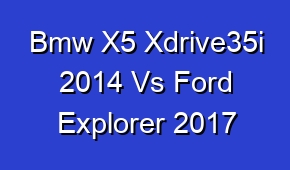Bmw X5 Xdrive35i 2014 Vs Ford Explorer 2017

Compare the 2014 BMW X5 xDrive35i with the 2017 Ford Explorer to see which SUV offers the best features, performance, and value. Find out how these two popular models stack up against each other in terms of design, technology, safety, and more.
| Feature | Bmw X5 Xdrive35i 2014 | Ford Explorer 2017 |
|---|---|---|
| Engine | 3.0L Inline-6 Turbo | 3.5L V6 |
| Horsepower | 300 hp | 290 hp |
| Torque | 300 lb-ft | 255 lb-ft |
| Transmission | 8-speed automatic | 6-speed automatic |
| Drive Type | All-wheel drive | Front-wheel drive (optional all-wheel drive) |
| Fuel Efficiency (Combined) | 20 mpg | 20 mpg |
| Seating Capacity | 5 | 7 |
| Cargo Space | 35.8 cu ft (behind 2nd row) | 21.0 cu ft (behind 3rd row) |
| Infotainment System | iDrive with 6.5-inch display | SYNC with 4.2-inch display (optional SYNC 3 with 8-inch display) |
| Bluetooth Connectivity | Yes | Yes |
| Backup Camera | Yes | Yes |
| Blind Spot Monitoring | No | Optional |
| Keyless Entry | Yes | Yes |
| Power Liftgate | Yes | Optional |
| Parking Sensors | Front and rear | Rear |
| Heated Seats | Optional | Optional |
Engine
The BMW X5 Xdrive35i 2014 is equipped with a 3.0L Inline-6 Turbo engine, while the Ford Explorer 2017 comes with a 3.5L V6 engine. The BMW offers 300 horsepower and 300 lb-ft of torque, whereas the Ford provides 290 horsepower and 255 lb-ft of torque.
Transmission and Drive Type
The BMW X5 Xdrive35i 2014 features an 8-speed automatic transmission and all-wheel drive, providing enhanced control and traction. On the other hand, the Ford Explorer 2017 comes with a 6-speed automatic transmission and front-wheel drive, with the option for all-wheel drive.
Fuel Efficiency and Seating Capacity
Both vehicles offer a similar fuel efficiency of 20 mpg combined. The BMW X5 Xdrive35i 2014 has a seating capacity of 5, providing ample space for passengers. In contrast, the Ford Explorer 2017 can accommodate up to 7 passengers, making it suitable for larger families or those needing extra seating.
Cargo Space and Infotainment
The BMW X5 Xdrive35i 2014 provides 35.8 cubic feet of cargo space behind the second row, offering ample room for luggage or groceries. The Ford Explorer 2017 offers 21.0 cubic feet of cargo space behind the third row. In terms of infotainment, the BMW features iDrive with a 6.5-inch display, while the Ford offers SYNC with a 4.2-inch display (optional SYNC 3 with an 8-inch display).
Additional Features
Both vehicles come equipped with Bluetooth connectivity and a backup camera. The Ford Explorer 2017 offers optional blind spot monitoring, while the BMW X5 Xdrive35i 2014 does not have this feature. Keyless entry is available in both vehicles, and the BMW also includes a power liftgate. The BMW has front and rear parking sensors, while the Ford only has rear sensors. Both vehicles offer optional heated seats.





















